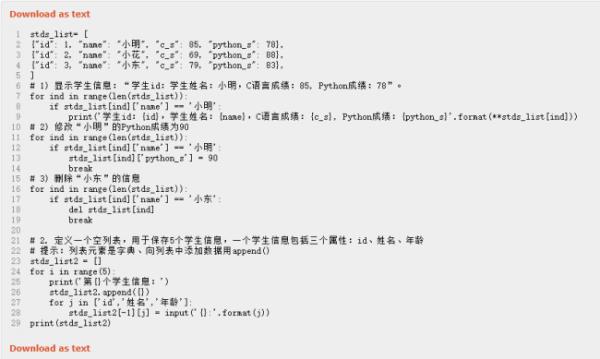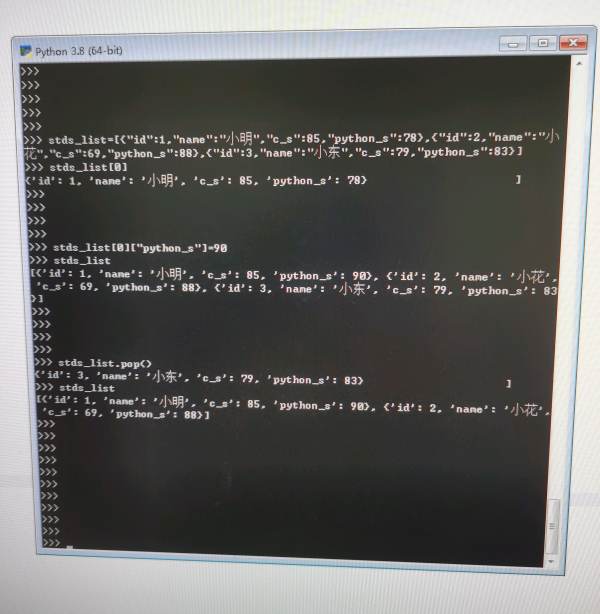python练习题怎么做?
Posted
tags:
篇首语:本文由小常识网(cha138.com)小编为大家整理,主要介绍了python练习题怎么做?相关的知识,希望对你有一定的参考价值。
练习:字典
1. 定义字典元素的列表:stds_list= [
"id": 1, "name": "小明", "c_s": 85, "python_s": 78,
"id": 2, "name": "小花", "c_s": 69, "python_s": 88,
"id": 3, "name": "小东", "c_s": 79, "python_s": 83,
]
1) 显示学生信息:“学生id:学生姓名:小明,C语言成绩:85, Python成绩:78”。
2) 修改“小明”的Python成绩为90
3) 删除“小东”的信息
2. 定义一个空列表,用于保存5个学生信息,一个学生信息包括三个属性:id、姓名、年龄
提示:列表元素是字典、向列表中添加数据用append()
stds_list= [
"id": 1, "name": "小明", "c_s": 85, "python_s": 78,
"id": 2, "name": "小花", "c_s": 69, "python_s": 88,
"id": 3, "name": "小东", "c_s": 79, "python_s": 83,
]
# 1) 显示学生信息:“学生id:学生姓名:小明,C语言成绩:85, Python成绩:78”。
for ind in range(len(stds_list)):
if stds_list[ind]['name'] == '小明':
print('学生id:id,学生姓名:name,C语言成绩:c_s, Python成绩:python_s'.format(**stds_list[ind]))
# 2) 修改“小明”的Python成绩为90
for ind in range(len(stds_list)):
if stds_list[ind]['name'] == '小明':
stds_list[ind]['python_s'] = 90
break
# 3) 删除“小东”的信息
for ind in range(len(stds_list)):
if stds_list[ind]['name'] == '小东':
del stds_list[ind]
break
# 2. 定义一个空列表,用于保存5个学生信息,一个学生信息包括三个属性:id、姓名、年龄
# 提示:列表元素是字典、向列表中添加数据用append()
stds_list2 = []
for i in range(5):
print('第个学生信息:')
stds_list2.append()
for j in ['id','姓名','年龄']:
stds_list2[-1][j] = input(':'.format(j))
print(stds_list2)

代码缩进
参考技术A第一题:
1
>>> stds_list[0]
'id': 1, 'name': '小明', 'c_s': 85, 'python_s': 78
2
>>> stds_list[0]["python_s"]=90
3
>>> stds_list.pop()
第二题
student_info=[]
student_info.append("id":1,"name":"A","age":10)
student_info.append("id":2,"name":"B","age":10)
student_info.append("id":3,"name":"C","age":10)
student_info.append("id":4,"name":"D","age":10)
student_info.append("id":5,"name":"E","age":10)
print(student_info)

8道python练习题,能做出来的没几个
-
变量的定义
程序就是用来处理数据的,而变量就是用来存储数据的
-
很多人学习python,不知道从何学起。
很多人学习python,掌握了基本语法过后,不知道在哪里寻找案例上手。
很多已经做案例的人,却不知道如何去学习更加高深的知识。
那么针对这三类人,我给大家提供一个好的学习平台,免费领取视频教程,电子书籍,以及课程的源代码!
QQ群:1097524789 -
Python3 的六个标准数据类型中:
不可变数据(3 个):Number(数字)、String(字符串)、Tuple(元组); 可变数据(3 个):List(列表)、Dictionary(字典)、Set(集合)。
-
变量的命名规则
在Python程序中,变量是用一个变量名表示,变量名必须是大小写英文、数字和下划线(_)的组合,且不能用数字开头
-
字符串常用方法
-
find方法可以在一个较长的字符串中查找子串,他返回子串所在位置的最左端索引,如果没有找到则返回-1
a = ‘abcdefghijk‘ print(a.find(‘abc‘)) #the result : 0 print(a.find(‘abc‘,10,100)) #the result : 11 指定查找的起始和结束查找位置 -
join方法是非常重要的字符串方法,他是split方法的逆方法,用来连接序列中的元素,并且需要被连接的元素都必须是字符串。
a = [‘1‘,‘2‘,‘3‘] print(‘+‘.join(a)) #the result : 1+2+3 -
split方法,是一个非常重要的字符串,它是join的逆方法,用来将字符串分割成序列
print(‘1+2+3+4‘.split(‘+‘)) #the result : [‘1‘, ‘2‘, ‘3‘, ‘4‘]
-
strip 方法返回去除首位空格(不包括内部)的字符串
print(" test test ".strip()) #the result :“test test”
-
replace方法返回某字符串所有匹配项均被替换之后得到字符串
print("This is a test".replace(‘is‘,‘is_test‘)) #the result : This_test is_test a test
-
-
常见操作练习
‘‘‘
1. str = "" 写一个函数,只去掉字符串右侧的空格,左侧的空格保留
‘‘‘
def fun1(s):
a = s[s.find(‘f‘):]
print(a)
return a
?
if __name__ == ‘__main__‘:
str=‘ fgh ‘
fun1(str)
?
?
‘‘‘
2. 输入10个数字到列表中,如果输入的不是数字,则跳过,不存
‘‘‘
def fun2(a):
alist = []
while True:
if len(a) == 10:
if a.isdigit():
alist.append(a)
print("存入成功:", alist)
else:
print("请输入10位‘数字‘")
else:
pass
print("请输入‘10位‘数字")
return a
?
if __name__ == ‘__main__‘:
a=input("请输入数字:")
fun2(a)
?
?
‘‘‘
3. 写一个函数,可以判断一个字符串是否为回文例子qwewq,函数返回true或者false
‘‘‘
def fun3(s):
if s == ‘‘.join(reversed(s)):
print(True)
else:
print(False)
?
if __name__ == ‘__main__‘:
s=input("请输入字符串:")
fun3(s)
?
?
‘‘‘
4. 请手写一个函数,可以打印出 I‘m "ok" it‘s your‘s 注意必须是原样输出
‘‘‘
def fun4():
a = [‘I‘, ‘m‘]
b = "‘".join(a)
?
c = [‘"ok"‘]
d = ‘‘.join(c)
?
e = ["it‘s"]
f = ‘‘.join(e)
?
g = ["your‘s"]
h = ‘‘.join(g)
?
?
sum = b + " " + d + " " + f + " " + h
print(sum)
?
if __name__ == ‘__main__‘:
fun4()
?
?
‘‘‘
5. str2 = "This is the voa special English,health,report" 写一个函数,统计字符串中单词出现的个数,注意是单词而不是字母
‘‘‘
def fun5():
str2 = "This is the voa special English,health,report"
a = str2.split()[:-2]
b = str2.split()[-1].split(‘,‘)
for i in a:
print(i,a.count(i))
for i in b:
print(i,b.count(i))
if __name__ == ‘__main__‘:
fun5()
?
?
‘‘‘
6. My_str = ‘11sdsfsdf45sfxcv67qwe_9’ 手写一个函数,计算出字符串中所有数字的和
‘‘‘
def fun6():
My_str = ‘11sdsfsdf45sfxcv67qwe_9‘
sum = 0
for i in My_str:
if i.isdigit():
sum += int(i)
else:
pass
?
print(sum)
return sum
?
if __name__ == ‘__main__‘:
fun6()
?
?
‘‘‘
7. s = ‘<a href="www.test.com">test</a>‘ 写一个函数,能将字符串中的网址提取出来,即提取出www.test.com
‘‘‘
def fun7():
s = ‘<a href="www.test.com">test</a>‘
link = re.findall(r‘<a href="(.*?)">‘,s)[0]
print(link)
if __name__ == ‘__main__‘:
fun7()
‘‘‘
8. str = "卡巴斯基#杀毒软件#免费版#俄罗斯#" 手写一个函数,将该字符串解析为[‘卡巴斯基‘, ‘杀毒软件‘, ‘免费版‘, ‘俄罗斯‘]
‘‘‘
def fun8():
str = "卡巴斯基#杀毒软件#免费版#俄罗斯#"
a = str.replace("#",‘ ‘).split()
print(a)
if __name__ == ‘__main__‘:
fun8()以上是关于python练习题怎么做?的主要内容,如果未能解决你的问题,请参考以下文章